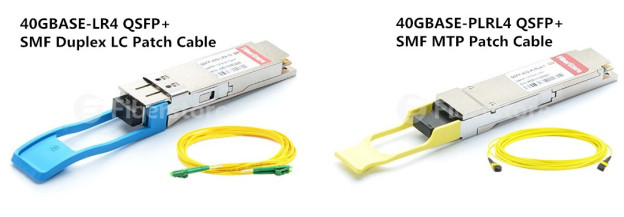- به وبلاگ خود خوش امدید
- Analysis of A Practical CWDM System Deployment Case
- Why Not Use EDFA Amplifier in Long CATV Network?
- Why Not Using DWDM Technology to Build Your Network?
- Optical Transponder—an Important Component in WDM System
- How to Build an Economical Long-haul 500Gbps Metro Network?
- Fiber Optical Communication
- Why Do We Need Optical Transponder (O-E-O)?
- CWDM Technology—Economically Saving Fibers for Your Network
- Confused About Loss in the Long Haul DWDM Network?
آخرین مطالب
امکانات وب
When choosing QSFP+ transceivers for designing 40G Ethernet network, you may hear the descriptions like ldquo;Single-mode QSFP+rdquo;, ldquo;Multimode QSFP+rdquo;. Are you familiar with these modules? What do these words stand for? Whatrsquo;s the difference between these two QSFP+ modules? Which one should you choose to deploy your 40G Ethernet network? And what should be noticed when using them?
In fact, the words single-mode and multimode here mean the different types of optical fibers that QSFP+ transceivers work with. For instance, single-mode QSFP+ means that QSFP+ transceivers run through single-mode fibers (SMF), while multimode QSFP+ will work with multimode fibers (MMF). In this article, we will have a discussion about the differences between the two QSFP+ transceivers and introduce the notice when using them.
Generally, single-mode QSFP+ transceivers mainly work in 1310nm wavelength, mostly applied for 40G long distances transmission, such as, 1km, 2km, 10km and 40km. It can be divided into many types according to the different transmission distance, while the color of its compatible fiber optic patch cord is always yellow. As for its connector, it usually uses duplex LC connector, but sometimes works with MPO/MTP connector. You can take QSFP-40G-LR4 module and QSFP-40G-PLRL4 module as examples shown in the following figure.

As for multimode QSFP+, it always works in 850nm wavelength which is only suitable for short distance applications. It has the ability to transmit 40G signals over OM4 at lengths up to 500m. Although it canrsquo;t transmit signals for long distance, it is capable to transmit many kinds of optical signals. As for the color of its compatible fiber optic patch cord, it can be orange, aqua or light blue. Besides, it usually uses MPO/MTP connector, but there are still some multimode QSFP+ with duplex LC connectors. For instance, QSFP-40G-CSR4 transceivers with MPO/MTP connector and QSFP-40G--UNIV transceivers with duplex LC connectors, as shown in the following figure.

As we all know, the laser light source of SMF is very strong, while the transmission mode of SMF only causes little modal dispersion in the signal transmission. All these facts make single-mode QSFP+ perform with higher bandwidth and much longer transmission distances when transmitting signals. Compared with multimode QSFP+, it has a much higher performance in signal transmission.
As for multimode QSFP+, it is clearly different from the previous one. Multimode QSFP+ always works with MMF that has a much bigger core and usually uses wider wavelength of light. As the laser light source of MMF is not so strong as the previous one and there is a seriously large dispersion caused by the transmission mode of MMF, multimode QSFP+ canrsquo;t transmit signals for long distance. Based on these reason, multimode QSFP+ is much cheaper than single-mode QSFP+. Besides, it is capable to transmit many kinds of optical signals, while single-mode QSFP+ can only transmit one kind of optical signal.
No matter which QSFP+ transceivers you choose to deploy 40G Ethernet network, you should be noted a lot of things before installation. Firstly, you should ensure that the QSFP+ in both ends of the fiber patch cord are with the same wavelength. You can simply confirm it by the color of the modules that should be consistent. Secondly, aiming at data accuracy, short-wave QSFP+ modules should be better used with multimode patch cords (ie. aqua OM3 or OM4 fiber patch cord), while long-wave QSFP+ modules need to work with single-mode patch cords (ie. yellow fiber patch cord). Thirdly, do not over bend or winding fiber optic cables, which increases the attenuation of light in transmission. Finally, please use a dust plug to protect the optical bore when the QSFP+ is not working.
Single-mode QSFP+ and multimode QSFP+ have different transmission distance, light wavelength, connectors and fiber optic patch cord, which are the most important factors you should consider when making a choice. Except these factors, the costs for transceiver modules will be also considered. If you have a budget pressure and want to save more for deploying 40G Ethernet network, you can choose the compatible module without sacrificing any quality or reliability but only with a low cost.
Fiber Optical Communication...برچسب : نویسنده : afiberopticalcom1 بازدید : 46
لینک دوستان
- کرم سفید کننده وا
- دانلود آهنگ جدید
- خرید گوشی
- فرش کاشان
- بازار اجتماعی رایج
- خرید لایسنس نود 32
- هاست ایمیل
- خرید بانه
- خرید بک لینک
- کلاه کاسکت
- موزیک باران
- دانلود آهنگ جدید
- ازن ژنراتور
- نمایندگی شیائومی مشهد
- مشاوره حقوقی تلفنی با وکیل
- کرم سفید کننده واژن
- اگهی استخدام کارپ
- دانلود فیلم
- آرشیو مطالب
- فرش مسجد
- دعا
- لیزر موهای زائد
- رنگ مو
- شارژ
